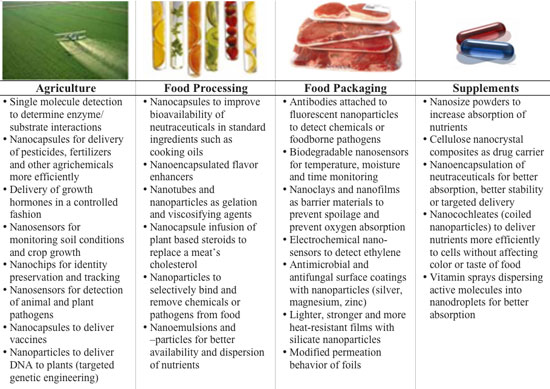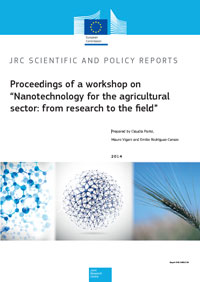| Posted: Aug 25, 2014 | |
Nanotechnology in agriculture |
|
| (Nanowerk Spotlight) Nanotechnology applications are currently being researched, tested and in some cases already applied across the entire spectrum of food technology, from agriculture to food processing, packaging and food supplements. In our special Food Nanotechnology section we have prepared an overview of this area. | |
 |
|
| Nanotechnology applications in the agriculture and food sector (Image ©: Nanowerk) | |
| Specifically in agriculture, technical innovation is of importance with regard to addressing global challenges such as population growth, climate change and the limited availability of important plant nutrients such as phosphorus and potassium. | |
| Nanotechnology applied to agricultural production could play a fundamental role for this purpose and research on agricultural applications is ongoing for largely a decade by now. This also touches on the issue of nanotechnology in developing countries. | |
 A recent “Workshop on Nanotechnology for the agricultural sector: from research to the field”, held on November 21-22 2013, reviewed the state-of-the-art of R&D of nanotechnology for the agricultural sector and analyzed possible markets and commercial pipeline of products. The proceedings from this workshop are now available for download (pdf). Here is a summary of the five major sections of this workshop. Overview of nanotechnology research activities in the agricultural sector The application of nanomaterials in agriculture aims in particular to reduce applications of plant protection products, minimize nutrient losses in fertilization, and increase yields through optimized nutrient management. |
|
| Despite these potential advantages, the agricultural sector is still comparably marginal and has not yet made it to the market to any larger extent in comparison with other sectors of nanotechnology application. | |
| Nanotechnology devices and tools, like nanocapsules, nanoparticles and even viral capsids, are examples of uses for the detection and treatment of diseases, the enhancement of nutrients absorption by plants, the delivery of active ingredients to specific sites and water treatment processes. The use of target-specific nanoparticles can reduce the damage to non-target plant tissues and the amount of chemicals released into the environment. Nanotechnology derived devices are also explored in the field of plant breeding and genetic transformation. | |
| The potential of nanotechnology in agriculture is large, but a few issues are still to be addressed, such as increasing the scale of production processes and lowering costs, as well as risk assessment issues. In this respect, particularly attractive are nanoparticles derived from biopolymers such as proteins and carbohydrates with low impact on human health and the environment. For instance, the potential of starch-based nanoparticles as nontoxic and sustainable delivery systems for agrochemicals and biostimulants is being extensively investigated. | |
| Nanomaterials and nanostructures with unique chemical, physical, and mechanical properties – e.g. electrochemically active carbon nanotubes, nanofibers and fullerenes – have been recently developed and applied for highly sensitive bio-chemical sensors. These nanosensors have also relevant implications for application in agriculture, in particular for soil analysis, easy bio-chemical sensing and control, water management and delivery, pesticide and nutrient delivery. | |
| In recent years, agricultural waste products have attracted attention as source of renewable raw materials to be processed in substitution of fossil resources for several different applications as well as a raw material for nanomaterial production (see for instance: "New synthesis method for graphene using agricultural waste"). Nanocomposites based on biomaterials have beneficial properties compared to traditional micro and macro composite materials and, additionally, their production is more sustainable. Many production processes are being developed nowadays to obtain useful nanocomposites from traditionally harvested materials. | |
| Commercial applications of nanotechnology in the agricultural sector | |
| From a commercial perspective, existing agro-chemical companies are investigating the potential of nanotechnologies and, in particular, whether intentionally manufactured nano-size active ingredients can give increased efficacy or greater penetration of useful components in plants. However, the nano-size so far did not demonstrate to hold key improvements in products characteristics, especially considering the interest of large scale production and the costs involved in it. | |
| Some specific nano-products for the agricultural sector have been put on the market by technology-oriented smaller companies, like soil-enhancer products that promote even water distribution, storage and consequently water saving. However, the commercial market application of these products is so far only achieved at small scale, due to the high costs involved in their development. These costs are normally compensated by higher returns in the medical or pharmaceutical sectors, but so far there are no such returns in the agricultural sector. Research continues in the commercial agro-chemical sector to evaluate potential future advantages. | |
| Companies are also facing challenges derived from the definition of nanomaterials that is adopted by the EU. One crucial point related to the EU definition is the possibility that non-active substances already used for many decades in commercial products formulations will fall within the scope of the nano definition, although not intentionally developed as nanoparticles or having specific nano-scale properties. Nanoscale formulants (e.g. clay, silica, polymers, pigments, macromolecules) have been used for many decades and are also ubiquitous in many daily household products. | |
| The concern is that the need for labelling of products that are already on the market since decades results in a scenario, in which the technology is stigmatized, preventing further and innovative applications of nanotechnology in agriculture. | |
| Nanotechnology risk assessment and regulation in the EU and worldwide | |
| Due to the variety of applications of nanotechnology, different pieces of legislation are concerned in the EU, including both horizontal legislation and product-specific legislation. The most comprehensive horizontal piece of legislation relevant to nanomaterials is the EU Regulation on Registration, Evaluation, Authorisation and Restriction of Chemicals (REACH), which addresses chemical substances, in whatever size, shape or physical state. Substances at the nanoscale are therefore covered by REACH and its provisions apply. Some researchers, however, argue that REACH needs to be revised in three major areas (read more: "Does the EU's chemical regulation sufficiently address nanotechnology risks?". | |
|
Among product-specific legislation, some already explicitly address nanomaterials (cosmetics, food additives, provision of food information to consumers, and biocides) while others do not (toys, electrical equipment and waste & environmental legislation). At international level, there are several activities in place on risk analysis of nanomaterials in the food and agriculture sectors, in particular by the governments of Australia/New Zealand, Canada, China, the EU, Japan, Switzerland and the US. Overall, definitions of nanomaterials developed in different countries result in different risk management measures. So far, apart from the EU, no country has set a regulatory framework for the mandatory labelling of nanomaterials in food and current regulations do not cover all areas (see for instance: "Gaps in U.S. nanotechnology regulatory oversight"). Socio-economic issues of agricultural nanotechnology |
|
| The emergence of nanotechnology applications in consumer products has also raised a number of ethical and societal concerns in some countries, starting from health and environmental safety, to consumer perception and intellectual property rights. | |
| From different studies about consumer acceptance of nanotechnology products, it appears that the public opinion is generally not negative. The public seems to be unconcerned about many applications of nanotechnology with the exception of areas where societal concern already exists such as pesticides. | |
| As for many emerging technologies, intellectual property in nanotechnology, and in particular freedom to operate, constitute relevant issues for the development of new products. The number of patent applications in nanotechnology has increased more than tenfold during the last 20 years, demonstrating a great potential for commercial applications. Patenting on nanotechnology in general presents some important concerns (read more: "Legal implications of the nanotechnology patent land rush"). Nanotechnology is pervasive in different fields of applications and nano-based inventions could infringe existing granted patents in those fields. This risk of overlapping patents can also have consequences for the agri-food sector. Moreover, patent holders could lock-up huge areas of technology. There are indeed already over 3,000 patents worldwide for potential agrochemical usage of nanotechnology but they are most likely patents with broad claims, filed with the scope of guarantee freedom to operate in the field in case of future commercial developments. | |
| In developing countries nanotechnologies can have important applications in several agri-food areas, such as food security, input delivery, rice production systems, agri-biotechnology, healthcare of animals, precision farming, food industry and water use (read more: "Small is beautiful? Nanotechnology solutions for development problems"). However, the main factors limiting the development of these applications are low investments in manpower training and in research infrastructure. | |
 By
Michael
Berger
– Michael is author of three books by the Royal Society of Chemistry:
Nano-Society: Pushing the Boundaries of Technology,
Nanotechnology: The Future is Tiny, and
Nanoengineering: The Skills and Tools Making Technology Invisible
Copyright ©
Nanowerk LLC
By
Michael
Berger
– Michael is author of three books by the Royal Society of Chemistry:
Nano-Society: Pushing the Boundaries of Technology,
Nanotechnology: The Future is Tiny, and
Nanoengineering: The Skills and Tools Making Technology Invisible
Copyright ©
Nanowerk LLC
|
|
|
Become a Spotlight guest author! Join our large and growing group of guest contributors. Have you just published a scientific paper or have other exciting developments to share with the nanotechnology community? Here is how to publish on nanowerk.com. |
|
